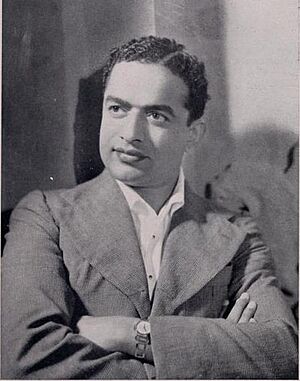V. Shantaram facts for kids
Quick facts for kids
V. Shantaram
|
|
|---|---|

Shantaram in 1938
|
|
| Born |
Shantaram Rajaram Vankudre
18 November 1901 Kolhapur, Kolhapur State, British India
|
| Died | 30 October 1990 (aged 88) Mumbai, Maharashtra, India |
| Nationality | Indian |
| Other names | Annasaheb |
| Occupation |
|
| Years active | 1921–1987 |
| Spouse(s) |
Vimalabai
(m. 1921)Jayashree
(m. 1941; div. 1956)Sandhya
(m. 1956) |
| Awards | Best Director 1957 Jhanak Jhanak Payal Baaje Best Film 1958 Do Aankhen Barah Haath Dadasaheb Phalke Award 1985 Padma Vibhushan 1992 |
V. Shantaram (born Shantaram Rajaram Vankudre) was a famous Indian filmmaker. He was born on November 18, 1901, and passed away on October 30, 1990. People also called him Shantaram Bapu or Annasaheb.
He was a talented film director, producer, writer, and actor. He made many popular films in both Hindi and Marathi. Some of his well-known movies include Dr. Kotnis Ki Amar Kahani (1946), Amar Bhoopali (1951), Jhanak Jhanak Payal Baaje (1955), and Do Aankhen Barah Haath (1957).
Contents
Early Life and First Steps in Film
Shantaram was born in 1901 in Kolhapur, a city in Maharashtra. His family was Marathi Jain. He was a cousin to another famous Marathi film director, Master Vinayak.
When he was a teenager, around 1917, his family faced financial difficulties. He moved to Hubli in Karnataka and started working. He got a job as a fitter in a railway workshop. He earned a small amount, but his hard work impressed his boss, and his pay increased.
In the evenings, he worked as a doorkeeper at the NEW Deccan Cinema Theatre in Hubli. He didn't get paid, but he could watch all the movies for free! This is where he saw films by Dadasaheb Phalke, who is known as the father of Indian Cinema. Watching these movies made Shantaram fall in love with filmmaking. He also learned photography and sign painting in Hubli. He later said that the moment he touched a camera, he felt a strong connection to it.
He began his film journey doing small jobs at the Maharashtra Film Co. in Kolhapur. In 1921, he acted for the first time in a silent film called Surekha Haran.
A Long and Creative Career
Shantaram had an amazing career in films that lasted for almost 70 years. He was one of the first filmmakers to understand that movies could be used to bring about positive change in society. He used his films to promote kindness and fairness, and to speak out against unfairness.
He was also very interested in music. People say he often helped his music directors create songs, even "ghost-writing" some tunes. He was very particular about music, and songs often had to be rehearsed many times before he approved them.
His Marathi film Manoos was even praised by the famous comedian and filmmaker Charlie Chaplin. Chaplin reportedly loved the movie a lot!
Starting Film Companies
In 1927, Shantaram directed his first film, Netaji Palkar. Just two years later, in 1929, he helped start the Prabhat Film Company. He founded it with Vishnupant Damle, K.R. Dhaiber, S. Fatelal, and S.B. Kulkarni.
Under his direction, Prabhat Film Company made Ayodhyecha Raja in 1932. This was the very first film ever made in the Marathi language!
In 1942, he left Prabhat Company to start his own studio called "Rajkamal Kalamandir" in Mumbai. Over time, Rajkamal became one of the most advanced film studios in India.
Introducing New Talent
Shantaram helped many new actors get their start in the film industry. In 1964, he introduced his daughter Rajshree and the famous actor Jeetendra in his film Geet Gaya Patharon Ne.
He also introduced Ranjana Deshmukh, who was his third wife Sandhya's niece, to the Marathi film world. This happened through the film Chandanachi Choli Ang Ang Jaali in 1975, which was directed by his son Kiran Shantaram. Ranjana became a very popular actress in Marathi films during the 1970s and 1980s.
Family Life
In 1921, Shantaram married Vimalabai. They had four children: a son named Prabhat Kumar (after whom he named his first film company) and three daughters, Saroj, Madhura, and Charusheela.
Later, in 1941, Shantaram married actress Jayashree. They had three children together: a son named Kiran Shantaram, who also became a film director, and two daughters, Rajshree and Tejashree.
In 1956, he married another leading actress, Sandhya. She had starred in many of his films, including Amar Bhoopali and Do Aankhen Barah Haath. Sandhya became very close with Vimalabai and her children.
Awards and Honors
V. Shantaram received many important awards for his contributions to Indian cinema.
- In 1985, he was honored with the Dadasaheb Phalke Award. This is the highest award in Indian cinema.
- After he passed away, he was given the Padma Vibhushan in 1992. This is the second-highest civilian award in India.
His film Amar Bhoopali was shown at the 1952 Cannes Film Festival in France. His film Do Aankhen Barah Haath won a special prize called the Silver Bear at the 8th Berlin International Film Festival in 1958. It also won a Golden Globe Award in 1959.
A special postage stamp dedicated to Shantaram was released by India Post in 2001 to honor him. The V. Shantaram Award was also created to recognize other filmmakers, and it is given out every year on November 18, his birthday.
Death
V. Shantaram passed away on October 30, 1990, in Mumbai. He left behind his three wives and seven children.
Images for kids


